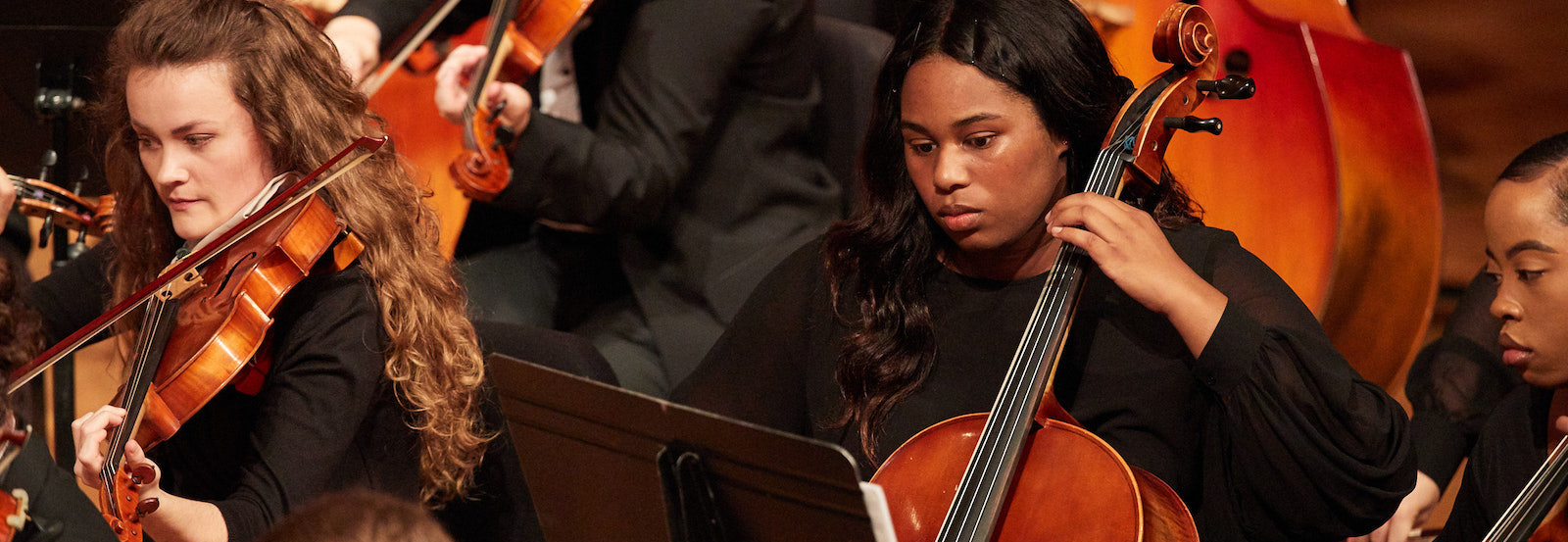Music
Memphis Fellowship Program (MFP)

The Rudi E. Scheidt School of Music and the Memphis Symphony Orchestra (MSO) have joined to create the Memphis Fellowship Program (MFP), a prestigious performance fellowship program for exceptional string players. The program provides a one to two year learning experience for up to four graduate and post-graduate violin, viola, and cello players coming from African-American and Latino communities that are historically underrepresented in classical music.
Three positions are available for the 2022-2023 season.
- 1 violin
- 1 viola
- 1 cello
MFP applicants must complete a Fellowship Application Form and apply to the program of their choice to set up an audition time. Applications will be accepted through the Rudi E. Scheidt School of Music audition deadlines.
Program Benefits
MFP Fellows receive a full tuition scholarship while enrolled in either the Master of Music or Artist Diploma programs. A stipend and contract package totaling a minimum of $12,500 will be provided by the MSO.
Professional Performance Opportunities
MFP Fellows perform a minimum of five concert cycles per season with the MSO, and participate in additional performances in solo and chamber setting for community engagement and education. Fellows will also play together in a Fellowship Ensemble as part of their experience at the Rudi E. Scheidt School of Music, where they will receive coachings and performance opportunities throughout their degree programs.
MFP Fellows engage in intensive study with the string faculty of the University of Memphis, and are paired with MSO mentors who provide guidance throughout the duration of their degree and fellowship. They have apprenticeship opportunities with the MSO music director and conducting staff, instrumentalists, CEO and administrative staff, MSO Board members, and members of the MSO Circle of Friends. Lastly, Fellows will serve as Rudi E. Scheidt School of Music ambassadors in the Memphis community both individually and as an ensemble.
1. Solo repertoire:
- An outer movement of a standard concerto from the 19th or 20th century
- Two contrasting movements of one of Bach’s Sonatas or Partitas for solo violin
2. Orchestral excerpts:
- Beethoven: Symphony No. 9 | Mvt 3: measures 99-115
- Debussy: La Mer | [19] to [20]
- Mozart: Symphony No 39, K543 | Mvt. 1:1st 9 measures | Mvt. 1: [A] to [C] | Mvt. 4: beginning to downbeat of 1 measure before [A]
- Prokofiev: Symphony No. 1, op. 25 (Classical) | Mvt. 1:Beginning to [7] | Mvt. 4:Beginning to [52]
- Strauss, R.: Don Juan, op. 20 | Entire 1st page
3. Possible sight-reading from the standard orchestral repertoire
1. Solo repertoire:
- A movement of a Bach Suite
- A movement from one of the major viola concertos such as Bartok, Walton, or Hindemith’s Der Schwanendreher
2. Orchestral excerpts:
- Beethoven: Symphony No. 5, op. 67 | Mvt 2
- Berlioz: Roman Carnival Overture, op. 9 | First page
- Mendelssohn: A Midsummer Night’s Dream, op. 61 | Scherzo: [B] to [D]
- Prokofiev: Symphony No. 1, op. 25 (Classical) | Mvt. 4: [69] through 1st measure of [73] | Mvt. 4: [75] to the end
- Strauss, R.: Don Juan, op. 20 | Beginning to downbeat of [B]
3. Possible sight-reading from the standard orchestral repertoire
1. Solo repertoire:
- An outer movement of a standard concerto
- Two contrasting movements of a Bach Suite
2. Orchestral excerpts:
- Beethoven: Symphony No. 5 | Mvt 2: measures 1-10, measures 49-59, and measures 98-106 |
- Brahms: Symphony No. 2 | Mvt. 2: Beginning to two measures before [A]
- Debussy: La Mer | Mvt. 1: Top line of quartet at two measures before [9] through four measures before [10]
- Mendelssohn: A Midsummer Night’s Dream | Scherzo: Top line, [N] to downbeat of [O]
- Strauss, R.: Don Juan, op. 20 | Beginning to five measures before [D]
3. Possible sight-reading from the standard orchestral repertoire

